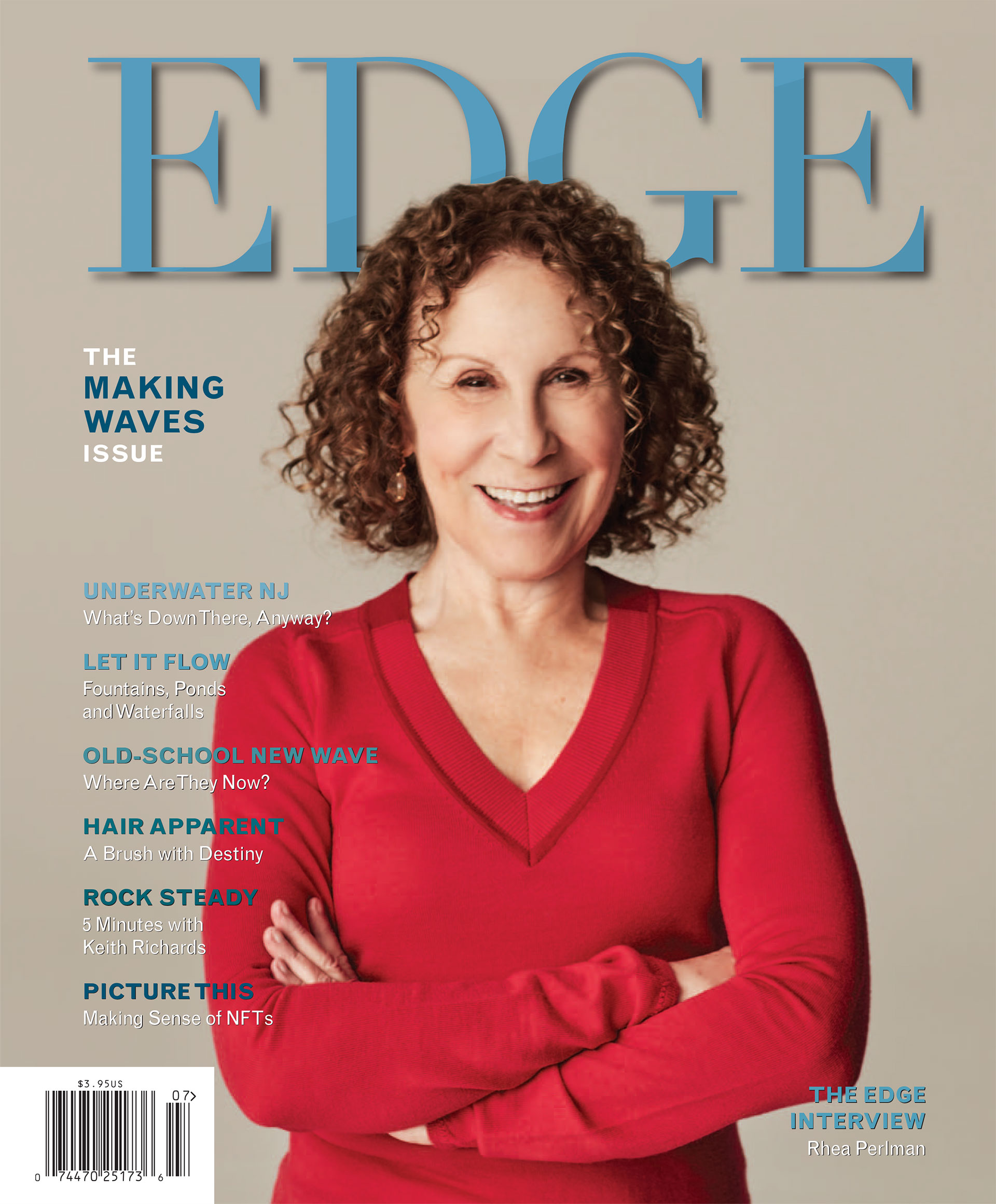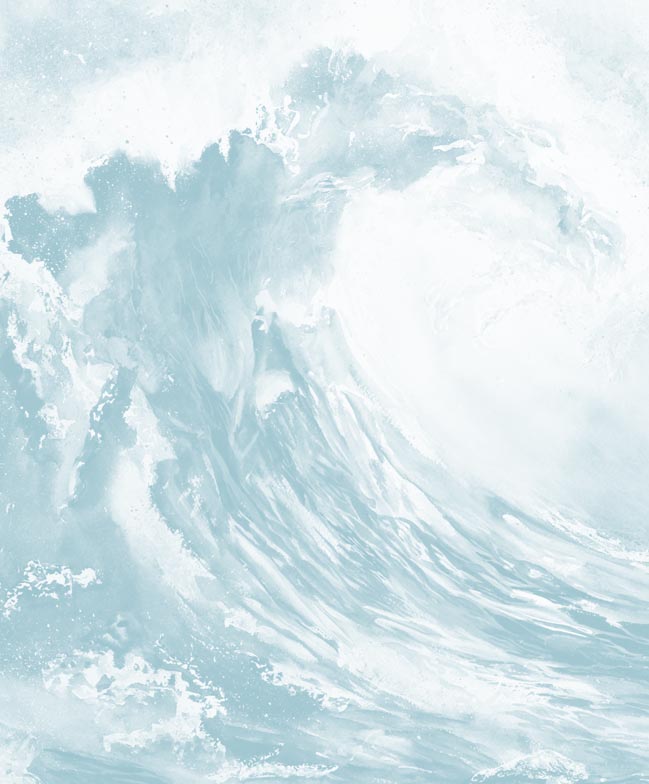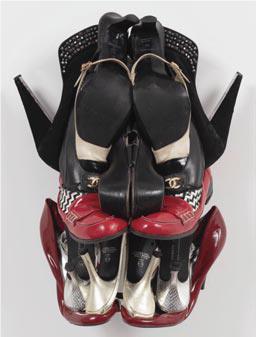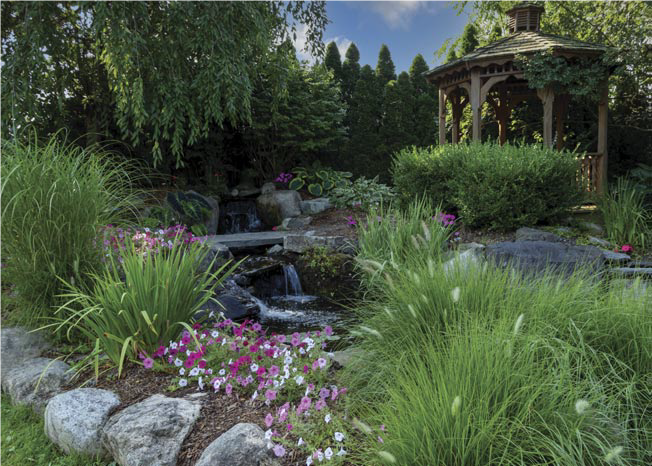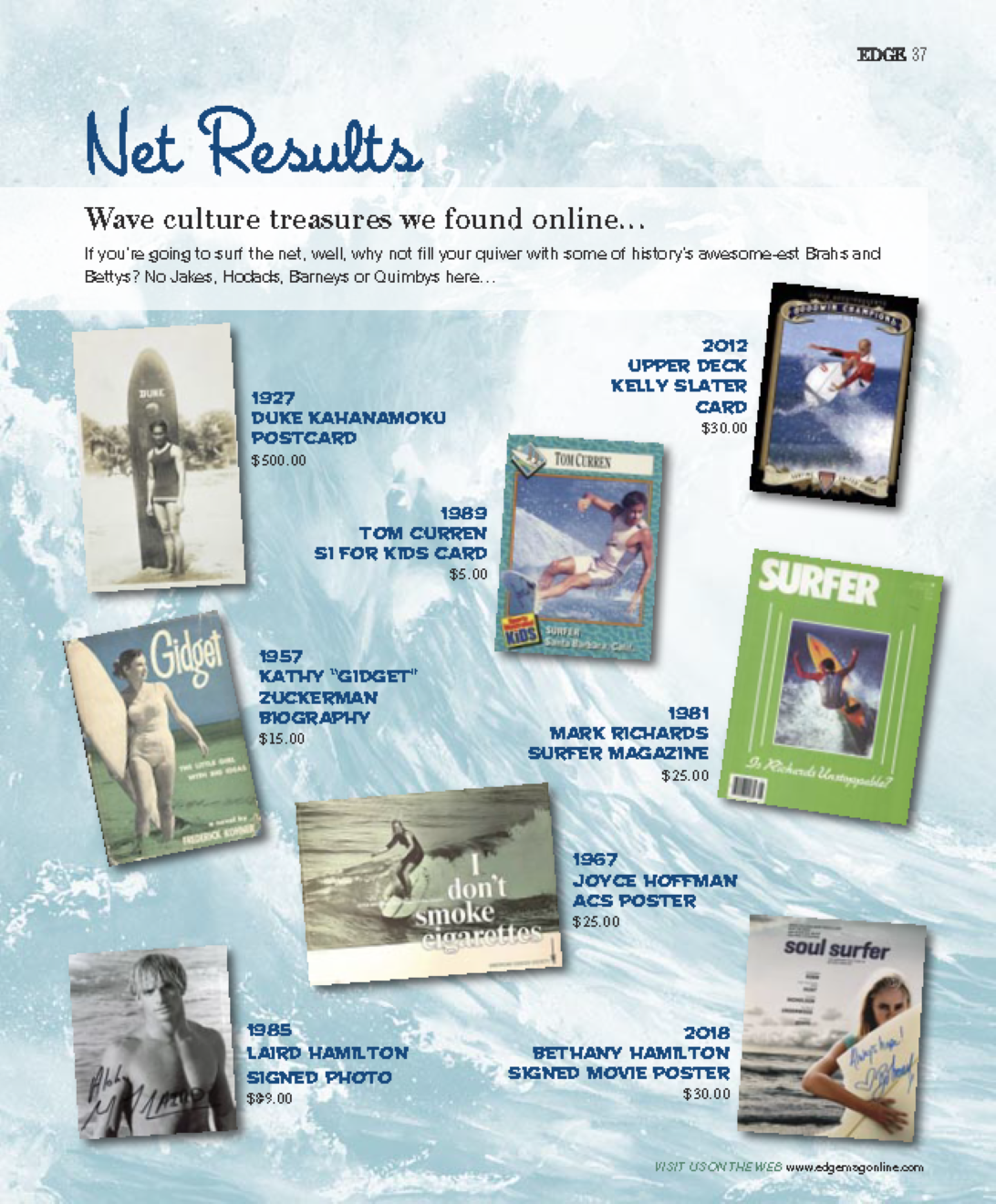
EDGE takes you inside the area’s most creative kitchens.
 Sonny’s Indian Kitchen • Sonny’s Butter Chicken
Sonny’s Indian Kitchen • Sonny’s Butter Chicken
225 Main Street • CHATHAM (973) 507-9462/9463 • sonnysindiankitchen.com
Sonny’s butter chicken is one of the best, delicious, smooth buttery and richest among Indian curries. It is made from chicken marinated overnight and baked in a clay oven then simmered in sauce made with tomatoes, butter and various spices.
— Chef Sonny
 The Thirsty Turtle • Pork Tenderloin Special
The Thirsty Turtle • Pork Tenderloin Special
1-7 South Avenue W. • CRANFORD (908) 324-4140 • thirstyturtle.com
Our food specials amaze! I work tirelessly to bring you the best weekly meat, fish and pasta specials. Follow us on social media to get all of the most current updates!
— Chef Rich Crisonio
 The Thirsty Turtle • Brownie Sundae
The Thirsty Turtle • Brownie Sundae
186 Columbia Turnpike • FLORHAM PARK (973) 845-6300 • thirstyturtle.com
Check out our awesome desserts brought to you by our committed staff. The variety amazes as does the taste!
— Chef Dennis Peralta
 Common Lot • Wagyu Beef Tartar
Common Lot • Wagyu Beef Tartar
27 Main Street • MILLBURN (973) 467-0494 • commonlot.com
Our wagyu beef tartar is paired with a Singapore style pepper sauce, summer herbs and flowers and sea beans.
— Head Chef/Owner Ehren Ryan
 The Famished Frog • Mango Guac
The Famished Frog • Mango Guac
18 Washington Street • MORRISTOWN (973) 540-9601 • famishedfrog.com
Our refreshing Mango Guac is sure to bring the taste of the Southwest to Morristown.
— Chef Ken Raymond
440 Parsonage Hill Road • SHORT HILLS (973) 467-8882 • par440.com
It’s pan seared and served over corn, black beans, peppers, celery and pineapple, with a corn coulis sauce.
— Chef Pascual Escalona Flores
Galloping Hill Road and Chestnut Street • UNION (908) 686-2683 • gallopinghillcaterers.com
Galloping Hill Caterers has been an incredible landmark for over 70 years. We pride ourselves in delivering “over the top” cuisine, impeccable service and outstanding attention to detail. That is the hallmark of our success! Simply, an unforgettable experience. Pictured here is one of our crepes flambé that really creates lots of excitement!
— George Thomas, Owner
Welcome Back!
The restaurants featured in this section are open for business and are serving customers in compliance with state regulations. Many created special items ideal for take-out and delivery and have kept them on the menu—we encourage you to visit them online.
Do you have a story about a favorite restaurant going the extra mile during the pandemic? Post it on our Facebook page and we’ll make sure to share it with our readers!
For bunion and hammertoe sufferers, minimally invasive surgery is where the rubber meets the road.
Your feet are not tires. When they wear out, there is no replacing them. That being said, there are a number of painful podiatric conditions that can now be resolved with minimally invasive surgical procedures. It’s not like purchasing a brand-new set of Michelins, of course, but in many cases the end result is a smooth, bump-free “new tire” feel. Two of the most common foot deformities, in fact, are now correctable through a tiny, two-millimeter incision: hammertoe and bunions.
These specialized techniques have been around for a while, notes Dr. Aqsa Siddiqui, DPM, who performs the surgeries at Trinitas, however, “not many podiatrists have been trained in this procedure, so it’s not done at every hospital. It has an excellent track record and very high rate of success, so as a result, we’re seeing more and more podiatrists being trained now. Bunions and hammertoe are different deformities with different plans, of course. However, we are able to treat both with minimally invasive surgery and correct each of those problems.” Hammertoe is a biomechanical imbalance in the foot, due to an imbalance of muscles at the top and bottom of the foot, which causes contraction, typically at a toe’s middle joint. It is a democratic (small d) condition that breaks roughly 50-50 male/female, from all ages and walks of life, and from all nationalities and cultural backgrounds.
“We do see a fair number of young people with this condition,” Dr. Siddiqui says. “But typically my patients tend to have had the condition for a very long time—10, 20 even as long as 40 years—and it is causing constant pain and discomfort. They have already gone through other options, including trying different shoes with, say, a more spacious toe box, or orthotics or other conservative treatments, but nothing has helped.
Now they need something a bit more aggressive to correct the deformity.” Minimally invasive hammertoe correction involves a two-millimeter incision, through which podiatrists trained in this technique can go in and release the tendon and capsule, and then make small cuts to the bone to bring the toe up and reposition it properly, so it is no longer contracted. The surgery doesn’t involve any screws or plates; a special splinting of the toe is added within the post-operative dressing, and the bone naturally heals in the correct position within a few weeks. If a patient has multiple hammertoes, Dr. Siddiqui says she prefers to do one toe first and monitor how it responds to the procedure. “After that,” she says. “I will do the remaining ones together.”
The traditional surgery to correct hammertoe involves a recovery time up to six weeks for the toe to fully heal. The recovery time for the minimally invasive procedure, by contrast, is very quick. The patient leaves the hospital or surgical center in a walking boot (so there is no real down time) and the post-operative pain is minimal. A few days of Motrin usually quells any discomfort. The splint is removed after a week and, after two weeks, patients transition into a surgical shoe and can begin range-of-motion exercises. Between two and four weeks, they are fully healed. After that, they are good to slowly return to normal activities, including sports.
Dr. Siddiqui’s affiliation with Trinitas dates back a decade. After graduating from the New York College of Podiatric Medicine in 2012, she completed her three-year residency at TRMC. From there she accepted a wound-care and limb-salvage specialty fellowship before returning to Trinitas as an attending physician, working with residents and performing minimally invasive procedures. She began gravitating toward this specialty after her uncle, who lived in Pakistan, suffered a wound on his toe and ended up having to have it amputated. “I was studying here at the time,” she recalls, “and I think that was probably what got me interested in podiatry. I soon realized that it’s a great field. There is such a variety of things you can do to help people and make a difference…and still have your own personal life.”
The recovery time for minimally invasive bunion correction is similar to that of the hammertoe procedure: You’re walking out of the hospital in a boot, which you’ll wear for a week or two, before transitioning into a shoe. Within four weeks, patients are fully healed. Whereas the causes of hammertoe tend to be consistent, not all bunions are created equal. The people limping into Dr. Siddiqui’s office may have developed bunions from a lifetime of repetitive stress or a genetic predisposition or as a result of flat feet—or some combination of causes. A mechanical imbalance of the muscles and tendons can also cause the deformity. Bunions are sometimes bilateral, but usually one foot is more severe than the other. What is unusual about the human foot that makes a bunion likely to form where it does, in the metatarsophalangeal joint of the big toe?

www.istockphoto.com
“The MTP joint is a very important joint that we use when we’re walking,” Dr. Siddiqui explains. “We roll off that joint. When there is an imbalance of the muscles, it can deviate that joint, causing that deformity. This in turn can cause damage to the cartilage in that area. Over time, the natural progression is that the big toe moves inward, overlapping or underlapping the second toe, or just squeezing against it. If the condition is not corrected, it progresses further and further into a severe deformity.” Traditional corrective surgery for bunions often involves opening up the entire toe and inserting plates and screws—frankly, to the layman it can sound a bit medieval.
Plus, there are occasional healing issues and complications and in some cases the pain and the bump can return after a certain amount of time. That is one reason bunion sufferers tend to opt for more conservative fixes, even before considering a minimally invasive procedure. Dr. Siddiqui is on board with this approach. “When a patient comes to me with pain in that joint, we like to begin with conservative treatments—injections, orthotics, physical therapy, comfortable shoes,” she says. “But if that isn’t helping, or if the pain returns, then surgery is an option.”
As with the hammertoe procedure, the bunion surgery involves a two-millimeter incision, through which a tiny drill can go in and shave off the bump, after which a cut can be made in the bone in such a way that it enables the surgeon to move the head of the metatarsal and reposition the toe. The technique involves a specific cut at a specific angle, which can be accomplished through the tiny incision. Can bunions come back? “Sometimes bunions do come back,” she says, “but from what I’ve seen—and this is echoed by other podiatrists who have been doing this for many years—compared to traditional surgeries, patients undergoing the minimally invasive procedure do really well in that regard.” So when is it time to kick the tires on bunion correction surgery? That’s an individual choice, of course.
And yes, Dr. Siddiqui is aware that there are folks out there who think they’ll just tough it out. “However, they should be aware that bunions don’t go away and tend to get worse,” she cautions. Indeed, the road to a more severe deformity can be paved with nerve damage, pain in the other toes, bursitis and eventually arthritis. Unfortunately, at the point when cartilage damage has progressed to where the joint doesn’t move anymore (hallux limitus), your options for a u-turn will likely be few and far between.
Editor’s Note: Dr. Aqsa Siddiqui, DPM, performs all of her minimally invasive procedures at Trinitas. She is in private practice in Carteret at The Foot Care Center of New Jersey, (908) 652–6077.
Not surprisingly, the devil is in the details.

www.istockphoto.com
Most of the things we spend money on combine two elements that determine their pricing or worth: the utilitarian and the subjective. While a refrigerator is more useful than a masterpiece painting, it holds a much lower market value. One is practical and common, the other is aesthetical and unique. Once any society has enough material goods to meet its basic needs, it starts to create (and assign value to) things that have no utilitarian purpose. The entire art industry, for example, exists only because a consensus of people decides that this painting or that sculpture is aesthetically valuable…and therefore it is valuable. Every so often, the perceived value of a particular product triggers a trend, which can explode into a collective “mania.”
An NFT, which is short for Non-Fungible Token, simply enables people to go crazy over a non-physical thing.
Spoiler alert: This may be the only “simple” idea in the pages that follow.
A year ago, I penned a feature for EDGE that attempted to explain cryptocurrencies in general, and Bitcoin in particular. The assignment was to make the article informative and entertaining. I am told the story received very positive feedback from readers who wanted a rudimentary explanation of them from someone who started with a rudimentary understanding of the topic. From that rudimentary understanding, my personal conclusion was that—owing to my wariness of the underlying fundamentals and my suspicion of all the hype—it was not for me. Since then, despite the best efforts of Larry David, Matt Damon, and other celebs who hopped aboard the crypto train, the dollar values of many cryptocurrencies, including Bitcoin, have plummeted by two-thirds or more.
In that story, I did not mention Ethereum, a second major player in the business, which is similar to—but not a carbon copy of—Bitcoin. Ethereum operates on a newer form of blockchain that has set off the latest round of speculative bedlam by introducing to the crypto universe a “digital asset” called an NFT. I wasn’t exactly shocked when EDGE called and asked me to take a shot at explaining NFTs to the magazine’s readers.
So what is an NFT? First off, let me say that I’m neither the first person nor the last to attempt a brief, simple yet coherent answer to this question. Let me also say that, in a world saturated with mis-, dis- and mal-information, much of what I encountered online while researching and writing this story was problematic—and in the case of one NY-Metro newspaper, mostly wrong.
Let me take you back to where I started: the drawing board. While I do, however, keep in mind something Ayn Rand once said: “Greed is the desire for the unearned.”
NFT By the Letters

www.istockphoto.com
Let’s start with the F in NFT: fungible. It’s an adjective with a textbook definition: “Of goods contracted for without an individual item being specified, replaceable by an identical item…or mutually interchangeable.” A bag of salt is fungible. If you want one, any one will do. Picasso’s Guernica? There is only one. This is where the N in NFT comes into play. Guernica is non-fungible. Non-fungible things tend to be more valuable than fungible ones.
Can a fungible item “become” non-fungible? Indeed it can. Think of an 8 x 10 publicity photograph of Tom Cruise, which might be printed in the hundreds or thousands. These are fungible. However, once Tom signs one of these photos, that single autographed print is technically unique and non-fungible—although you could argue that one Cruise scrawl is no different than another. Nonetheless, it would certainly be more valuable.
Now let’s talk about the T in NFT. It stands for Token, though not the kind you used to use on the subway or move around a Monopoly board. In this context, a token is a unit of value that is recorded as a receipt on something called a blockchain; if you’ve heard of NFTs or cryptocurrency, you’ve no doubt encountered this word. The people who use it toss it around as if everyone else obviously knows what it means…which is not the case…because it’s incredibly complicated. I offered an explanation of the blockchain in my cryptocurrency story last year and I think I’ve gotten a bit better at it since then. Here goes:
Let’s say that you want to buy a pair of shoes from Bob’s Boutique, which charges you $100. You don’t have cash, so you insert your debit card. The terminal sends a message to your bank that says I have an account with you and want to spend $100 at Bob’s Boutique… please send $100 to Bob’s bank. This is the meat and potatoes of what banks do millions and millions of times all day, every day, meticulously recording every transaction. At the end of each day, they tally up all the transactions and settle the accounts; your account balance is reduced by $100 and Bob’s is increased by $100. We trust our banks to keep perfect records, which is why we call them fiduciaries. It’s a system that’s been around since Renaissance Italy, and it works pretty well. With the advent of Internet 2.0 and the 2008 financial crisis (when a lot of folks had their faith in banks shaken), some brainy computer expert types started to wonder if there might be a way to create equally perfect and trustworthy records for these gazillions of transactions, but without those fiduciary third parties, the banks. Thus was born the blockchain.
A blockchain accomplishes the same accounting task as banks. However, instead of using two private ledgers for the buyer and the seller, all transactions are recorded together on the Internet, in a single, unalterable public ledger. In the crypto universe, Bob charges you the same price for your shoes (let’s call it 100 “coins”). You use your “crypto wallet” to move 100 coins into Bob’s account, and the transaction is recorded on your crypto coins’ blockchain. A large number of computers around the world maintain and monitor the blockchain ledger, in real time, 24 hours a day. All of those computers then confirm and approve your transaction.
A few years ago, the folks at Ethereum looked at this and saw that an adaptation of the blockchain ledger technology could be used to keep track of—and certify ownership of—a digital file, such as a Tweet or a JPEG or a GIF, by attaching a unique digital certificate to its purchase/sale transaction entry. That certificate is called a token—hence the T in NFT—and if said certificate is unique, it is also non-fungible: the NF in NFT. It tells the world that you own the original version of whatever that file happens to be, even if someone else copies or steals it.

The Value Proposition
How does one determine the value of an NFT? This is where I join you in a little head-scratching. Boosters of NFTs say that they’re like unique collectible cards that anyone can see online, but only one person can claim ownership of them at any given time. The concept behind an NFT is that this scarcity—which exists, is recognized and is understandable in the physical world—will confer a similar value in the virtual world of the Internet.
Can an NFT be copied? Yes. However, the original NFT address can be traced back to the original creator, since all NFTs have an indelible record of their transaction history on the blockchain. One of the current criticisms of NFTs, however, is that unlawful copies can be difficult to detect and police.
I know. I give up, too. But let’s keep moving.
There are four principal metrics of NFTs that determine their potential market value:
1) Primacy. Just as Bitcoin became the dominant cryptocurrency because it was the first, the first NFTs minted by certain creators and businesses tend to hold the highest perceived value. For example, Jack Dorsey’s first Tweet. You may have heard of the Bored Ape Yacht Club. It was the first “gallery” of digital art that caught the imaginations of celebrities and other people with way too much disposable income, and has since benefited from this caché, with prices for a cartoon ape bringing six- and seven-figure prices on OpenSea (more about that on the next page).
2) Scarcity. Think of a masterpiece painting. Everyone can have a copy of it and tack it up on their dorm room walls, but only one person (or museum) can hang the original. Or let’s say Madonna minted only one NFT ever—maybe a video file from her new documentary Madame X—but then tragically perished in a plane crash. Since there is only one, it might potentially become very valuable.
3) Provenance. Let’s say that Mark Wahlberg donates a leather jacket to a charity auction. It may have cost him $500 brand new, but now it’s just used clothing. Or is it? Because it’s celebrity used clothing, his fans might be willing to pay thousands for it. Now suppose that Mark wants to donate an NFT for a JPEG photo of himself and his family. Wouldn’t those same fans fight over that photo?

Gabbo T
4) Utility. Imagine if Taylor Swift sold 50 (and only 50) NFTs that granted their owners lifetime back-stage access to all of her live performances. These 50 NFTs would soar in value due to their real-world benefits. This is an example of a “smart contract,” which is an interesting quality of an NFT. Personally, I regard this as the only rational use for an NFT.
All four metrics are entirely dependent on the principle of “digital ownership.” NFTs are the digital equivalent of personal property. They reside in an owner’s crypto wallet, and for the most part can be used however and wherever the owner wants. If the “Metaverse” (uh-oh I see a third EDGE assignment coming!) takes off as the tech world believes it will, NFT “objects” will be used more and more in video games or other interactive situations where they would have monetary value.
Nuts and Bolts

www.istockphoto.com
How do you buy an NFT? Most are sold on marketplace web sites similar to eBay but specializing in NFTs, among them the aforementioned OpenSea. The vast majority are only available to be purchased using Ethereum, so you will need to own some Ether, the cryptocurrency developed by Ethereum to be just as dependable, but a little more nimble, than Bitcoin. Establishing a crypto wallet requires a degree of technical skill and, if you make a mistake, you might very well wind up losing your NFT, as well as your Ether.
Step 1: Create an account wallet on the NFT marketplace website of your choice
Step 2: Create an account wallet and purchase Ethereum on an exchange website
Step 3: Transfer your Ethereum from your exchange wallet to your marketplace wallet
Step 4: Bid in the auction for the NFT of your choice. If you win, that NFT is added to your marketplace account wallet. Where do you store your Ethereum and your shiny new NFT? The best place is on a third, offline “hardware wallet.”
Given how fast the NFT craze grew in 2021, you knew there would be some technical glitches. Some have been expensive. In one case, digital thieves were able to exploit a loophole in OpenSea’s exchange and snag an astronaut Bored Ape for $700,000 less than the asking price—and then flip it to another buyer for a quick profit.
Today there are tens of thousands of NFTs of all kinds—for visual art, music, sports videos… you name it. Since about 18 months ago, people have been buying all kinds—sometimes for boatloads of Ether. In March 2021, an NFT of a single JPEG image file sold at Christie’s auction house for $69 million worth of Ether. One month later, an NFT of Jack Dorsey’s first Tweet on March 22, 2006 (the very first Tweet) was bought for $2,915,835.47 (fun fact: it’s a prime number). An NFT of a LeBron James highlight video file sold for $208,000 just over a year ago.
It gets weirder. A 12-frame animation GIF by artist Chris Torres of a NYAN Cat with a frosted Pop Tart body flying through outer space, trailing rainbows behind it, sold for $600,000. Thousands of ape pictures created by Bored Ape Yacht Club (BAYC) are still generating hundreds of millions of dollars and are owned by some of the world’s most recognizable celebrities—including Snoop Dogg and Paris Hilton.
If you’re asking yourself just now: How are there so many idiotic NFT things that you’ve never heard of raking in so much lucre? Well, I’m with you. As a rule, anything two mental giants like Paris Hilton and Snoop Dogg are fascinated by, I turn from and run. Finally, here are my personal conclusions and, fair warning, they’re not favorable…
NFTs have all the earmarks of a scam IMHO (in my humble opinion)—a speculative bubble rife with ethical and financial rabbit holes. A “greater fool” game, if you will. It reminds me of what happened in the online retro games market not too long ago, when a bunch of dishonest guys bought each other’s collections to increase their perceived value—a practice known as “wash trading.”
NFTs depend on creating perceived value by fabricating scarcity that is normally found in physical objects. My question is, why restrict an infinitely reproducible digital file’s reproducibility unless you plan to sell it? Or, more precisely, resell it? You don’t buy an NFT to hang on your wall. You really can’t even keep other people from looking at it, if they want. You hope that its perceived value increases so you can dump it and make a profit.
If that sounds like stocks, bonds, commodities futures, etc. that are also speculative, it’s meant to. But trading in NFTs reminds me more of the old 1960s Milton Bradley party game, Time Bomb, where someone wound up the ticking egg-timer fuse on an explosive device and you’d pass it around a circle until it went off in some poor kid’s hands. It’s gambling, only with worse odds—like sitting down to a rigged poker game where the dealer and the other players are all working for the house.

So What Is an NFT, Really?
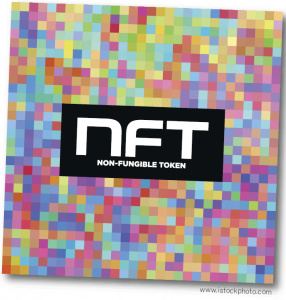
www.istockphoto.com
It is not much more than a gilded receipt for a digital luxury item. An original physical artwork is distinct from a reproduction; if you value that artwork, then there is genuine subjective benefit in owning it. But with digital art, reproductions are inherently perfect copies, so “original” means nothing. Anyone other than the owner can access and copy an NFT. The person copying it just can’t own it. In some cases, an NFT buyer doesn’t even get a traditional copyright (the buyer of the NYAN Cat, for example, did not receive the right to reproduce or merchandise the image from the artist). Meanwhile, many artists excited by NFTs’ potential as a revenue stream watched in dismay as their artwork was turned into unauthorized NFTs and sold without their knowledge or permission, in a market sorely lacking in effective oversight. That being said, among the most ardent supporters of NFTs as “the next generation of art” is Time magazine and its Timepieces Community, which features more than 20,000 NFTs.
NFTs might serve a use as a digital representation of a physical object, like a concert ticket—and are potentially great vehicles for money laundering. Otherwise, in and of themselves, I feel they are pointless.
NFT? No Freaking Thanks.
Editor’s Note: Luke Sacher is a documentary filmmaker who has written extensively on technology and popular culture for EDGE. Since he was assigned this story late in 2021, sales of NFTs have fallen more than 70%.


 After almost 60 years, do you enjoy the whole thing of being on tour, waiting for the concert?
After almost 60 years, do you enjoy the whole thing of being on tour, waiting for the concert?
It’s no big drag to travel around. You get to see people that you haven’t seen for a long time…hanging around with musicians and good friends. [The concert] is just something that you do at the end of the day. Actually, I’m quite happy to do it 60 years. After all, what else would I do? [laughs] I made this job up because I couldn’t think of anything else. I’d make a lousy plumber, you know? I’m very fortunate in finding what I wanted to do—and what I could do—very, very early in life and there’s never been any real doubt about that. So, in that case I’ve been very fortunate and give thanks and praises for it.
Did the passing of [drummer] Charlie Watts bring [the band] closer?
Yes, I do think so. When things like that happen, you do tend to draw together more, which I think is for the best of the band. The Rolling Stones are far bigger than any of its parts, you know. I always feel like I’m working for the Rolling Stones. I have no choice, I have to do this…I’m not complaining, I gotta say that. I’m sitting here, I’m ready to go to work.
I think the older you get, the healthier you become. Do you wonder about this yourself?
You know, if I ask questions about it, I might not like the answers. I’m just a fairly old bloke in pretty good shape. I spent half of my life taking up [unhealthy things] and half of my life giving them up. I don’t recommend this for everybody. I’m far from being indestructible. I just don’t break easy, you know?
Was smoking the hardest thing to give up?
I’d given up things far more addictive than nicotine. Actually, once I started doing it, I found it very easy. I stuck on the patch and said, “No more!” I know this doesn’t work for everybody. I’d tried to cut down smoking, but by the end of the week I’d find I’m smoking more. I really got disgusted with it eventually…and that was it. I found I had more stamina after that. Yeah, it’s definitely good. Give it all up. It’s good for you.
I get the impression that you are actually very young, a young spirit, a young man at heart.
I hope so. I’m holding out for my age as much as I can.
Are your grandkids curious about their granddad’s adventures in rock ‘n roll?
They are not old enough to know who I am. This is an incredible process, watching the little things grow up. I love ’em all. Yeah. I’m a grandfather, okay. [laughs]
Editor’s Note: Keith Richards turned 78 last winter. He formed The Rolling Stones with Mick Jagger and Brian Jones in 1962. The Stones are currently on a (briefly COVID-delayed) summer tour of Europe. This Q&A was conducted by Ken Summit of The Interview People.
What lies beneath may surprise you.
When the world imagines New Jersey, it pictures the opening drive from The Sopranos, an hours-long Bruce Springsteen concert, prizefights in Atlantic City, Tilly’s grin and the Asbury Park Boardwalk, Jersey Shore the reality show and Jersey Shore the beloved summer destination. New Jerseyans know better—there is a lot more to the state than meets the eye. For instance, we are surrounded by water on three sides, not just one, and our lakes and rivers offer endless opportunities for recreation. Something New Jerseyans may not know is that, under the surface of these picturesque bodies of water, there is a world of forgotten history, hidden secrets, and tantalizing clues to the past.
The Ice Age is a great place to begin our deep dive. During this period in Earth’s history, the frigid climate trapped a lot of the planet’s water in massive ice sheets, which in turn led to significantly lower sea levels—as low as 400 feet or more. The Atlantic coast extended far beyond what we now think of as the Jersey Shore. The Hudson River, meanwhile, didn’t end at Staten Island; it continued to cut through the exposed land for hundreds of miles, creating canyon three-quarters of a mile deep. We know it as the Hudson Canyon, a favorite fishing spot that also happens to be the largest known underwater canyon in the world. Too bad no one was around to see it back then.
Off the Hook
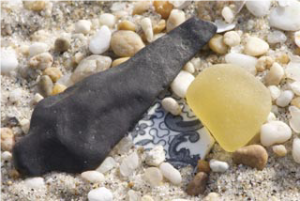
Guy Fleming
Well, hang on a minute. Do we know with absolute certainly that this land was unpopulated? The Ice Age ended and ocean levels began rising rapidly around 11,500 years ago. There is compelling evidence that humans had reached the Atlantic coast by then, which might have been 100 or more additional miles to the east. Called Paleo Indians by anthropologists, they would have hunted various now-extinct animals, including megafauna species that include mastodons, wooly mammoth and giant ground sloths. Evidence of their actual settlements would have been wiped away by the rapid rise of the ocean. However, fossilized animal bones are occasionally recovered far off shore, confirming that what we think of as the “sea floor” was once teeming with animals in the not-too-distant past.
In the 1990s, an ambitious dredging operation took place at the northern end of the coast to replenish eroding beaches. Much of the sand scooped up from a mile or more offshore was deposited in front of the towns of Sea Bright and Monmouth Beach—where beachcombers soon discovered hundreds of human artifacts, including stone tools and projectile points that pre-date the Lenape Indians who had inhabited the area before the coming of European settlers. These items appear to have been produced by the aforementioned Paleo Indians, at an offshore site that is believed to date back at least 10,000 years. The Paleo Indians spread across North America after arriving from northeast Asia via Beringia, the Ice Age land mass now submerged below the Bering Sea. When you stand facing the ocean, holding one of these ancient artifacts in your hand, it is impossible not to wonder what else is out there under the waves.

On the Lake Front

Upper Case Editorial
New Jersey’s lakes and ponds guard their share of secrets—some ancient and others from recent history. In 1954, Gus Ohberg, owner of a Sussex County sports shop, decided to expand the small lake on his property in Vernon Township. During the dredging, one of the workers spotted a large brown bone, which turned out to be a mastodon skull. Professionals were summoned to the site and eventually they uncovered the most complete mastodon skeletons ever found. The Ohberg Mastadon—renamed “Matilda” after the bride of one of the archaeologists on the project—was reassembled in Trenton, where it remains a favorite attraction at the State Museum more than six decades later. Matilda was a young female, a teenager, whose remains were carbon-dated to around 11,000 years old—near the end of the mastodon’s reign over North America, likely due to a combination of human hunting, disease and loss of habitat brought on by the end of the Ice Age, when the glaciers that carved through the northern half of New Jersey receded. Matilda may not have been the only member of her family to perish on the Ohberg property. Indeed, rumor has it that Mastodon Lake may have more secrets to reveal.
If you enjoy a mystery, know that the Round Valley Reservoir (right) in Clinton has been called “New Jersey’s Bermuda Triangle.” Since it opened to the public in the 1970s, more than 20 people have lost their lives swimming, boating and exploring there. People can’t resist a spooky story and, indeed, some insist the reservoir is cursed. Its allure to scuba divers, however, is the town that lies beneath its 55 billion gallons of water. The reservoir was completed in 1960, submerging a small farming community in the process. The project was initiated to meet Newark’s growing demand for water and Round Valley seemed like the perfect place to locate a reservoir.
All but one county (Hunterdon, where it was located) agreed, triggering eminent domain. Appraisers were sent to evaluate the 50 or so farms in the way so that the state could make an offer to residents that they literally couldn’t refuse. Some took the money and started anew. Others used a portion of the cash to re-purchase their family homes and then dismantle and physically relocate them. After it was all said and done—and tens of billions of gallons of water flooded the farms—the unthinkable happened: Newark pulled out. For the uninitiated, Newark’s relationship with its water supply has been historically (and often criminally) complicated, to say the least, and remains so. Thankfully, Round Valley still serves a purpose, as the water it sends through an underground pipeline makes its way to the Raritan River. And, as mentioned, it is a popular recreation and relaxation spot. Scuba divers can explore the foundations of many houses, a church, and a school—and maybe even spot a skeleton or two. It’s like New Jersey’s own little Atlantis.
Near the Shore
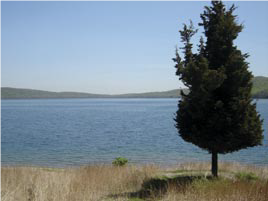
Deathworm
For more than three centuries beginning in the 1600s, the New Jersey coast was known unofficially as the graveyard of ships. Today, it has more shipwrecks per mile than any other state. Prior to the dredging of the current shipping channel in the 20th century, the approach to New York harbor was not a straight shot. Ships coming north had to hug the shoreline to remain in deep water, passing uncomfortably close to Sandy Hook in order to reach the Verrazano narrows. Vessels coming across the Atlantic had to aim directly at the shore and then make a hard turn to the right to find a channel deep enough to safely make it to port. An inexperienced captain or a violent storm could run a ship onto the sandbars, where it would be smashed to pieces.
One of the oldest wrecks off the coast of New Jersey is the HMS Zebra, a 14-gun sloop built by the British in 1777 to help crush the American Revolution. Its voyage ended abruptly in the fall of 1778 when the ship ran aground near Little Egg Harbor. The Zebra was part of the naval force controlling traffic in and out of the Delaware River, ensuring a constant flow of men and material to Philadelphia, one of the key cities in the colonies.
The struggle to control the waters around Cape May had been raging for two years by then. In the summer of 1776, the American colonists earned a critical early naval victory at the Battle of Turtle Gut Inlet, off Wildwood Crest. A spectacular American casualty in this meeting was the Nancy, a newly constructed brig that had sailed up from the Caribbean with a crew of 11, loaded with rum, sugar, gunpowder and arms. The British had already established a naval blockade of the area, with more than 200 cannons protecting the Delaware River. The Nancy (above) was spotted and pursued by a pair of British warships up the Jersey coast to the inlet, where it was purposely run aground so that longboats could be rowed out to salvage her precious cargo.

Winterthur Collection
The larger British vessels had to remain in deeper waters, but were close enough to fire on the salvage mission. The Nancy’s cannons fired back. When the offloading was complete, the Nancy’s flag was lowered, which the enemy took for a sign of surrender. Moments after boarding the disabled vessel, British forces discovered it was a trap: Using the Nancy’s mast as a fuse, the Americans had left 100 kegs of gunpowder aboard to blow her to splinters, sending more than a half-dozen redcoats to oblivion. The official seal of Wildwood Crest commemorates this event and the town also has a park with a memorial to those who served on the Nancy.
The wreck of the Nancy was a key moment in the early history of what was to become the U.S. Navy. Another maritime incident off the Jersey Shore gave birth to the U.S. Lifesaving Service, antecedent to the Coast Guard. A February 14th nor’easter in 1846 claimed several ships—some five off Sandy Hook alone—but it came to be known as the Minturn Storm. Among the casualties of the howling winds and driving snow was the Alabama, which ran aground near the Manasquan Inlet. A rescue attempt by ill-equipped locals failed and the crew perished. Many of the same good Samaritans turned their attention to the John Minturn, just four miles away in Mantoloking, later that day. The three-masted packet ship was carrying passengers and cargo from New Orleans when it slammed into the sand about 300 yards from shore. The rescuers worked for 18 hours and had more luck than with the Alabama, but there was still a tremendous loss of life. Only 10 people out of 50 survived and frozen bodies littered the beach.
No good deed goes unpunished and, sure enough, news stories reported that many of the bodies had their pockets turned inside out, calling the locals “barbarians.” The sensational tales triggered an investigation, which found that these people had risked their lives to save others, not to relieve corpses of their valuables. One account claimed that a body of a man wearing a gold belt buckle had washed up in Point Pleasant and was returned to his family still wearing the belt. The publicity generated by the Minturn Storm gave U.S. representative William Newell the momentum needed to push for the formation of an organized lifesaving corps. Two years later, the Newell Act called for the construction of a series of buildings to house the proper equipment to save people from wrecked ships. These Life Saving stations, which eventually popped up all over the east coast, were originally built along the shore from Sandy Hook to Little Egg Harbor, giving brave volunteers real equipment and a real chance of saving people.
Dan Lieb, president of the New Jersey Historical Divers Association, lists the John Minturn among the “Holy Grail” shipwrecks that he hopes to explore one day. Right up there with it is the New Era, which slammed into an outer sandbar off Asbury Park in 1854. Hundreds of passengers—mostly German immigrants—clung to the ship’s rigging, hoping to ride out the storm. Some made it, but most didn’t. About half of the 300-odd victims were interred in a West Long Branch cemetery, where a monument marks their mass burial. All kinds of rumors and controversy surrounded the wreck, most of which still linger to this day. Neither the John Minturn nor the New Era has been found yet—or, at least, not that Lieb knows. Often divers who discover a new wreck keep it to themselves.
By rough count, there are more than 5,000 sunken ships within 20 miles of the New Jersey coastline— hundreds of which can be explored by experienced divers. They include boats torpedoed during the two World Wars and victims of maritime collisions, an inevitable result of a busy shipping lane and unpredictable weather.

Upper Case Editorial
According to Lieb—who has completed over 2,000 dives since being certified in 1974—perhaps the most intriguing underwater wreck in New Jersey is not a shipwreck, but a trainwreck. A few miles off the coast of Long Branch, under 90 feet of water, two 1850s-era locomotives sit, nestled in the soft sand, side-by-side about 10 feet apart. Discovered in 1985, the trains are small (even for their time), weighing 15 tons apiece. The wheel layout is curious: three on each side, with the middle wheel larger than its neighbors. Their pattern of design (above) was common in England, Lieb points out, but a bell retrieved from the site raises the possibility that they may have been manufactured in Boston—or more likely the bell was added in Boston as the trains passed through New England on their way to their still-unknown final destination. It is not clear when the trains were lost, either. There are a number of scenarios that would pin their demise to a specific date, which could range from the 1850s to the end of the 19th century. For instance, the locomotives could have been headed to buyers in the Caribbean or South America, where rail systems were just being established, many decades after they were manufactured.
“Were they on their way to another country because they had become obsolete in America?” Lieb wonders. “I have visited them several dozen times. It’s quite interesting to see land-based vehicles underwater. They look so out of place.”
Another unknown is how the locomotives reached their final resting place. Obviously, they were being transported on a barge or some other vessel. But where is it? In 30-plus years of underwater exploring, no wreckage has been found. And what were the circumstances of their trip to the bottom? Did they break loose in heavy seas? Were they intentionally cut free, either to save the ship or perhaps to generate an insurance claim? Was it sabotage? None of these scenarios can account for the odd position in which they were found.
New Jersey’s waters have many more stories to tell. They provide snapshots of the past, protecting history from the elements of the surface world and preserving countless undiscovered treasures for future generations to explore.
Editor’s Note: The goal of the New Jersey Historical Divers Association (njhda.org) is to identify shipwrecks and bring their history to life. For those interested in exploring underwater New Jersey, a great starting point for new divers is to join a club or associate themselves with a dive shop and ask for recommendations.
OBJECT LESSONS:
From Ordinary to Extraordinary
With a bicycle seat and handlebars left on the side of a road, Picasso created “Head of a Bull,” famous icon of the artform Objets Trouvés—found objects. French-American artist Marcel Duchamp took a urinal, titled it “Fountain,” signed it, eh voilà!, another well-known icon of trouvé art. Ubiquitous things, such as shoes and plastic bottles, caught the poetic vision of artist Willie Cole. Put his two-dimensional works in the mix and observe the art made with a steam iron. And herein learn even more about the phenomenon called Artistic Seeing.
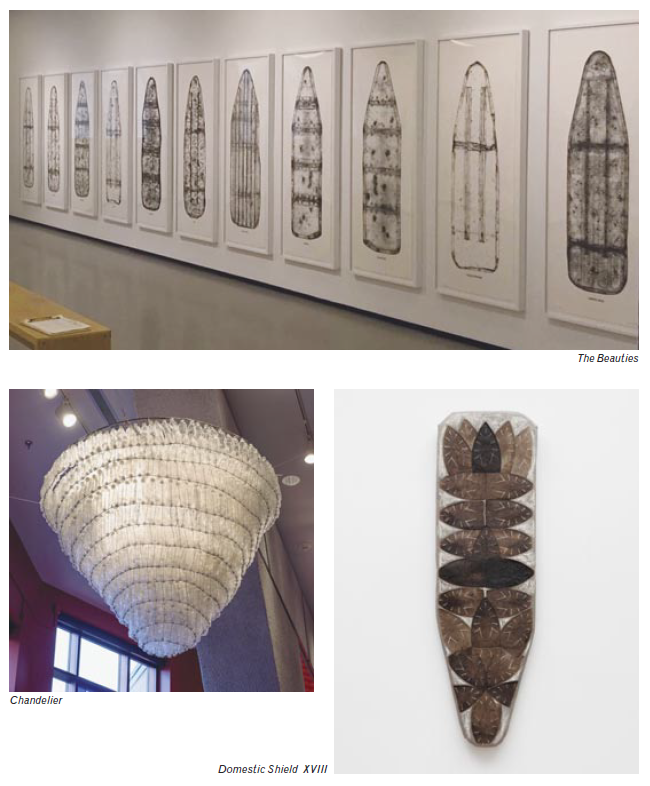
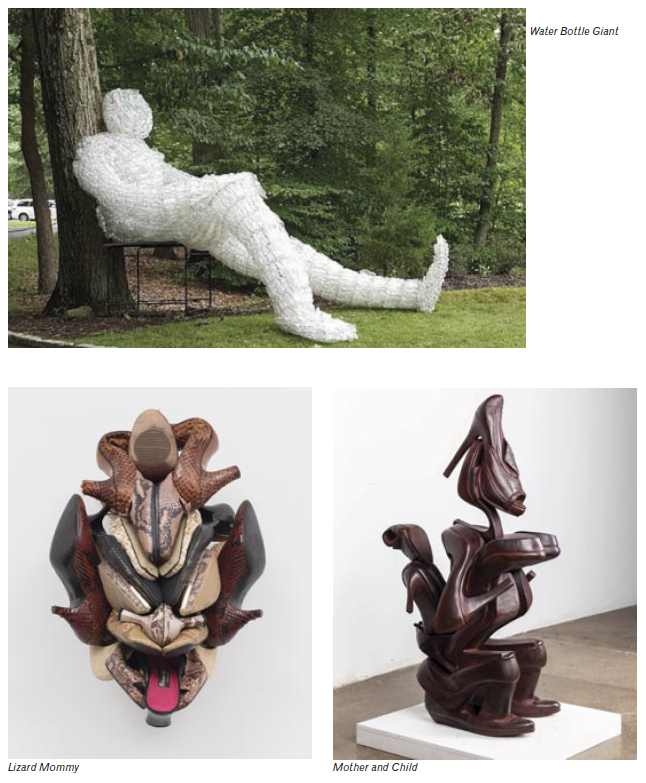

Portrait from the Heels Over Head series
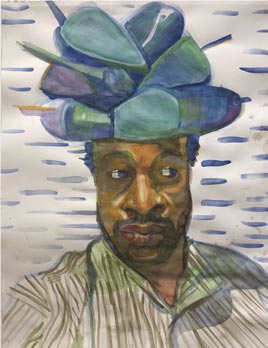
Portrait from the Heels Over Head series
About the Artist
 Born in 1955 in Somerville, Willie Cole, now living in the Morris County town of Mine Hill, NJ, infuses dynamism in ordinary objects built as African and other modern references. His sculptures, paintings and prints have been exhibited in the Museum of Modern Art and many other venues. A sculpture is in the Afrofuturist Period Room at the Metropolitan Museum of Art. His large-scale sculptures will be installed in the Kansas City International Airport in 2023. “My show at the Met’s Mezzanine gallery,” says Cole, “focuses on my print work with the steam iron. It’s a small show but a welcomed one.” Of course, you’ll never look at steam irons, plastic bottles, or shoes the same way again.
Born in 1955 in Somerville, Willie Cole, now living in the Morris County town of Mine Hill, NJ, infuses dynamism in ordinary objects built as African and other modern references. His sculptures, paintings and prints have been exhibited in the Museum of Modern Art and many other venues. A sculpture is in the Afrofuturist Period Room at the Metropolitan Museum of Art. His large-scale sculptures will be installed in the Kansas City International Airport in 2023. “My show at the Met’s Mezzanine gallery,” says Cole, “focuses on my print work with the steam iron. It’s a small show but a welcomed one.” Of course, you’ll never look at steam irons, plastic bottles, or shoes the same way again.
—Tova Navarra
Love it or hate it, New Wave has returned disguised as classic rock…and looks like it’s here to stay.
Music trends come and go. And often they come back again. Such is the case with New Wave, the genre that enjoyed a brief but notable heyday from the late-1970s to the late-1980s. A less-angry and more artistic offshoot of punk rock, New Wave was radio-friendly (remember radio?) and, at its height, helped launch the age of the music video. It was heavy on synthesizers, driving guitar and tinny percussion, light on traditional lyric structure. It ushered in a “second” British Invasion and launched the careers of several American rock superstars who are still making music today. And then, almost overnight, New Wave blipped out of existence, overtaken by an onslaught of grunge, rap, hip-hop, hair metal and electronic dance music—with many of its stars reemerging later on the alternative rock charts.
For tens of millions of Americans—most past 50 and many pushing 60—New Wave was the music they grew up on. It’s their classic rock, their comfort food. And, yes, you’re starting to hear those old riffs sampled in hip-hop tunes and in ads and played in the aisles of supermarkets and retail stores. It has its own Sirius XM channel and it’s probably just a matter of time until big pharma starts co-opting New Wave tunes for their drug commercials. Perhaps not surprisingly, the genre, which was the last sold primarily as vinyl, is also being rediscovered by hipsters, teens and tweens—often at the gentle urging of their parents or (yikes!) grandparents.
Alas, it would seem that we wrote off New Wave a bit prematurely. Turns out it was more than a pop-music flash in the pan. Its reemergence and staying power are testaments to the artistry and innovation of its creators. Who were they and where are they now? Here’s a look at ten of the best…
Blondie 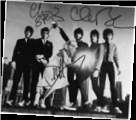
Way Back When…
Jersey Girl Deborah Harry and Brooklynite Chris Stein assembled Blondie in 1974 and ascended quickly to the vanguard of the New Wave movement. The band was popular abroad and in the dank music clubs of the East Village until their third album, Parallel Lines, blew up and made them bona fide superstars.
Big Hits
Heart of Glass, Call Me & The Tide Is High
Where Are They Now?
Blondie took a break in the early 1980s so that Stein could recover from a debilitating autoimmune disease, with Harry continuing to record as a solo artist. By the end of the decade, the pair had broken up as a couple. But Blondie re-formed in the late-1990s and produced the album No Exit, albeit to a lukewarm response. They continued to record and perform in the 2000s and were inducted into the Rock & Roll Hall of Fame in 2006. Harry and Stein announced a tour set to start in the spring of 2022, but the 72-year-old Stein ultimately stepped aside with heart issues.
The B-52s 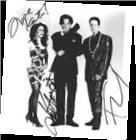
Way Back When…
The B-52s embraced a humorous, 1950s “trash-culture” ethos, with a mix of wacky lyrics and retro keyboard work. Kate Pierson and Fred Schneider handled vocals, while Ricky Wilson provided some memorable guitar licks.
Big Hits
Rock Lobster and Love Shack
Where Are They Now?
Although the B-52’s have toured more or less consistently—and put out new albums in 1992 and 2008—the band’s popularity faded in the mid-1980s following Wilson’s death from AIDS. They enjoyed a brief resurgence during the music-video boom with “Love Shack.” With Schneider and Pierson now both in their 70s, a farewell tour has been scheduled to begin later this summer.
The Cars 
Way Back When…
The Cars were at the forefront of New Wave’s calling card of guitar licks plus heavy synthesizer, releasing their first album in 1978. Ric Ocasek, on guitar and vocals, had a unique look that proved ideal for the MTV generation. The Cars won Video of the Year award at the very first MTV Video Music Awards in 1984. Their strong, minimalist style powered multiple hits during the decade.
Big Hits
Just What I Needed, Shake It Up & You Might Think
Where Are They Now?
After the band broke up in the late-1980s, Ocasek married super-model Paulina Porizkova, who had appeared in a Cars video when she was 18. The couple was estranged in 2019 when she found him dead in their still-shared New York City brownstone at the age of 75, from heart disease. The band had been inducted into the Rock & Roll Hall of Fame the previous year. Cars bassist Benjamin Orr, who shared lead vocals with Ocasek on several hits—including “Just What I Needed”—passed away from pancreatic cancer in 2000.
Elvis Costello 
Way Back When…
After cutting his teeth as a pub-rock punk artist in the early 1970s, Costello made a splash in the early days of New Wave with My Aim Is True. He formed a band called The Attractions and pumped out a string of albums produced by Nick Lowe, including This Year’s Model, Armed Forces and Almost Blue—which demonstrated the depth and breadth of his talent and are still top-sellers today.
Big Hits
Alison, Angels Wanna Wear My Red Shoes & Pump It Up
Where Is He Now?
Costello became one of the most in-demand musical collaborators of his time, pairing with everyone from Paul McCartney to Burt Bacharach to Annie Lennox, and also demonstrated his acting skill in several film and television appearances. In 2003, Elvis Costello & The Attractions were inducted into the Rock & Roll Hall of Fame. He married chanteuse Diana Krall that same year and had twin boys.
Duran Duran 
Way Back When…
The darlings of MTV in the network’s infancy, Duran Duran featured singer Simon Le Bon, bassist John Taylor, drummer Roger Talyor and keyboardist Nick Rhodes. They were one of the first bands to shoot their videos on 35 mm film and collaborate with established moviemakers. They won the first Grammy for Best Music Video in 1984 and rode their success to perform the title song to the 1985 007 film A View to a Kill.
Big Hits
Rio & Hungry Like the Wolf
Where Are They Now?
Constant reshuffling saw Duran Duran’s popularity ebb by the end of the 1980s. They continued to make music in the 1990s and experienced a resurgence in popularity in the 2000s, selling out show after show on tour in the US and UK. In 2012, they headlined at the Summer Olympics opening ceremony in London and in 2021 released the studio album Future Past to great fanfare.
Eurythmics 
Way Back When…
Annie Lennox and Dave Stewart broke off from The Tourists in 1981 to form Eurythmics, which blended electronic and psychedelic influences to produce a form of avant- garde pop that was utterly unique. After turning out their first album, Lennox suffered a nervous breakdown and Stewart nearly died from a collapsed lung. They recovered to produce Sweet Dreams, a huge success that also showcased Lennox as a music-video star.
Big Hits
Sweet Dreams (Are Made of This) & Would I Lie to You
Where Are They Now?
After issuing eight albums in eight years, Lennox and Stewart took a break for a decade to work on individual projects. They reunited in 1999 to record another album and appeared together sporadically thereafter, often as part of fundraising and tribute concerts. In 2019, Lennox released her eighth solo record, Lepidoptera.
The Police 
Way Back When…
What an interesting trio these guys were: Sting (trained as a teacher), Stewart Copeland (grew up in Beirut) and Andy Summers (a 35-year-old jazz guitarist) found one another in 1977 and formed the core of The Police. After making several top-selling albums on the international scene, the British band became New Wave megastars in America with the release of Synchronicity—their fifth and final studio album before breaking up in 1986.
Big Hits
Roxanne, Don’t Stand So Close to Me & Every Breath You Take
Where Are They Now?
The three key members of The Police decided to do their own things, and each continued to thrive. Sting sold millions of records as a solo artist and dabbled in acting—most recently in Only Murders In the Building, playing (and poking fun at) himself. Copeland, a transformative rock drummer, became a prolific composer of film scores and has written ballets and operas. Summers also turned out film scores—including Down and Out In Beverly Hills and Weekend at Bernie’s—and recorded a string of acclaimed jazz albums. Following their Hall of Fame induction in 2003, a reunion tour in 2007 sold out countless arenas.
The Pretenders 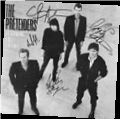
Way Back When…
Ohio-born Chrissie Hynde and Englishman Jimmy Honeyman-Scott blended their distinctly different musical styles to form the heart of The Pretenders in 1979. Hynde named the band after the Platters’ iconic hit “The Great Pretender.” They bowled over critics and developed an intensely loyal fan following, but the band was devasted in 1982 when Honeyman-Scott died of a cocaine overdose at age 25.
Big Hits
Don’t Get Me Wrong, Brass In Pocket & I’ll Stand by You
Where Are They Now?
Hynde reconstituted the band several times over, touring consistently and producing roughly one studio album per decade, including 2020’s Hate for Sale, which received a thumbs-up from fans and critics. In 2005, The Pretenders were inducted into the Rock & Roll Hall of Fame.
Talking Heads 
Way Back When…
Even when New Wave was new, Talking Heads were recognized as pioneers, blending punk, funk and world music into a dizzying array of hit songs and albums during a remarkable 16-year run that ended when the band broke up in the early 1990s. David Byrne, Tina Weymouth, Jerry Harrison and Chris Frantz explored percussion in its many forms and elevated winking, ironic lyrics to an art form—not surprising, as they all first met while art students in the early 1970s. Their 1984 film Stop Making Sense, directed by Jonathan Demme, is one of the most watchable concert movies of the 20th century.
Big Hits
Psycho Killer, Burning Down the House & Once in a Lifetime
Where Are They Now?
While his three bandmates toured in the 1990s without him as Shrunken Heads (!), David Byrne continued to make clever, sophisticated music and encouraged other musicians to remember that without “art” there is no artist. Among the performers that credit Talking Heads as a major influence are Vampire Weekend, Kesha, St. Vincent, Trent Reznor, Franz Ferdinand, Eddie Vedder, LCD Soundsystem and Radiohead, which actually took its name from one of the band’s 1980s songs. In 2019, Byrne starred on Broadway in American Utopia, which featured reimagined versions of several Talking Heads classics.
Tears for Fears 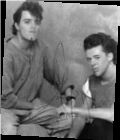
Way Back When…
Formed in the English city of Bath in the early 1980s, Tears for Fears was one of the lead bands in the so-called “Second British Invasion.” Band founders Roland Orzabal and Curt Smith were heavily influenced by the electronic music of Gary Numan (“Cars”) and Depeche Mode (“Just Can’t Get Enough”), as well as the lyrics of Peter Gabriel and David Byrne. They scored a pair of #1 hits in the U.S. in the mid-1980s and were huge stars on MTV.
Big Hits
Shout & Everybody Wants to Rule the World
Where Are They Now?
Success and “creative differences” drove Smith and Orzabal apart, leading to a break-up in the early 1990s. They reunited in 2000 and continued to tour and put out new music over the next two decades. In 2021, their album The Tipping Point reached #1 on Billboard’s Alternative chart and Tears for Fears is currently on tour here and in the UK.
Editor’s Note: As a teenager in the 1970s, Mark Stewart stumbled into several claustrophobic East Village clubs, where he was lucky enough to catch Blondie and Talking Heads. He also shared a house with the road manager of Duran Duran. David Byrne and Elvis Costello are still on heavy rotation in his CD player. (Remember CD’s?)
If you’re among the millions of dedicated television viewers who feel that sitcoms simply aren’t what they used to be, Rhea Perlman may shoulder some of the blame for that. Her 11-season turn as brash, vulgar and uninhibited Boston cocktail waitress Carla Tortelli on Cheers ranks among the most original and imaginative performances in entertainment history. If you don’t agree, tell it to her 10 Emmy nominations. Perlman’s ability to infuse her characters with a stunning range of qualities and emotions—from sugary sweet to disturbingly deviant—has kept her on Hollywood’s A-list for the better part of four decades. Her current project, 13: The Musical (airing on Netflix this August) brings Perlman back to her roots on the stage. Gerry Strauss caught up with Rhea to talk about the arc of her career and what tempted her to say Okay to her latest role in the midst of the pandemic.
EDGE: When did you first realize that you wanted to pursue acting? RP: That didn’t come until after college. I liked acting starting around high school, but never really thought that it was something you could do. I didn’t know anyone who was an actor. I didn’t come from a background of people who went into the arts at all. They didn’t explore that part of their lives in terms of making a living. So, when you talk about making a living, I didn’t know anyone who did that. But then after college I had a good friend who had written many plays while I was in school. He was very talented, and he got into Columbia Film School, and I would go up there sometimes. I lived in New York then, and I’d come act in a movie of his and there were a lot of people around him pursuing acting careers.
EDGE: What were you doing to make ends meet then?
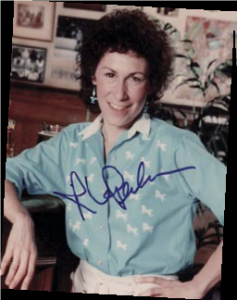
Upper Case Editorial
RP: I was like an assistant at a vet’s office. I thought I could do both of those things. I could be an assistant at Dr. Nelson’s office and try to become an actress. So, I took some classes. It was a slow roll to actually making this into a career.
EDGE: A lot of your fans first got to know you from your recurring role as Zena Sherman on Taxi—a sweet, mild-mannered character who couldn’t have been more different than Carla Tortelli.
RP: That’s funny. Zena was actually called “The Nice Girl” when the character was first created… that’s what she was called.
EDGE: Was it a challenge for you to convince the Cheers people that you could play tough-as-nails Carla?
RP: I really never thought about that when the opportunity to play Carla came up. I just thought, What fun this could be, playing a person that speaks their mind and doesn’t give a damn… someone who can be tough and that stuff. I never thought about having to convince anyone of anything. It just was, Wow, what a great part this is! EDGE: Had you played roles like that before?
RP: Coming from New York, and the little bits of work that I did there that I never got paid for—I mean, off-off-off-Broadway parts—I’d played many different kinds of people. And playing the bad guy was always fun. Carla, although not being a bad guy, had elements of that, and the people who cast me in it, who wanted me to play it, were people who knew me from Taxi: the Charles brothers [Glen and Les] and Jimmy Burrows. The Charles brothers wrote many Taxi episodes and were producers of it, and they also created Cheers. So, they wrote that part thinking of me.
EDGE: Was there anything about Carla that you suggested or made a personal choice to include in your performance?
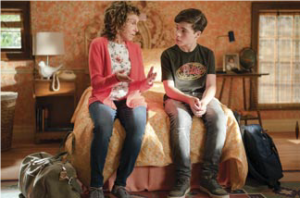
Netflix
RP: When Carla’s sister, who was very racy, was written into one episode, I just said, “Maybe I can play my sister”— and I did get to do that. As far as Carla goes, the writers were so great at writing all of our characters that I don’t think anybody did anything but enhance what they wrote.
EDGE: You touched on your stage background so I am wondering if that theater experience made the transition to television sitcoms a comfortable one?
RP: Yeah. I think that that was one of the things that made it easy, as you said. You’re right, it does feel like a play, even though you’re being filmed, and you can do things over—which is like the best of all worlds. Because when you’re in a play, you always want to do it over. You end up doing it over the next night, but you wish you could do it over right then [laughs].
EDGE: Your 1996 family film Matilda has become a classic. It’s watched and beloved by children and their parents to this day. Did you ever expect it to transcend generations as it has?
RP: Yeah! [laughs] I mean, I did have kids that were young at the time, and I know how they were with the movies that they watched—they watched their favorites over and over and over. They never wanted to stop watching it, whether it was animated or live action. I didn’t expect it to be, but I wished for it that it would be a classic movie. I mean, it did come from a Roald Dahl book and his books are classic.
EDGE: You’ve also lent your voice to a ton of characters from many of their favorites, including the Disney+ hit, Star Wars: The Bad Batch. Do you find a different type of creative freedom in giving a unique voice to characters who look nothing like you?
RP: I absolutely love doing the voices for animated characters and stuff like that. And I do think it’s freeing and fun and it’s challenging, too, trying to find a voice, although you usually play mostly yourself. If they cast me, they want me—they don’t want me to be sounding like a Wookie. You know what I mean? There are some incredibly talented people in the business who do lots of different voices. They can talk to themselves or even a group. They can be around a table doing every voice. I wish I had that talent. It would be incredibly fun, but I love doing what I do.

Netflix
EDGE: In some respects now you’ve returned to your roots for your latest project, Netflix’s 13: The Musical. How did you get connected to this undertaking?
RP: You know what? Out of the blue. I just got an offer through my agent from somebody at Netflix, or Tamra Davis, who is the director of the film. Someone asked for me and I said, “Okay!” I think I got the offer and had to be there in a week. That was challenging because it was during the pandemic and there were a lot of costumes to get, and there was nowhere to shop…not for me, but for the designers—especially in Toronto, where everything was incredibly locked-down.
EDGE: What excited you enough about the role to make that leap on such short notice?
RP: Well, I loved the idea of working with kids, and that every kid in that show was 13 or 14 years old at most. They are incredible. I just got to watch the movie last week and it’s a ton of fun, with great dancing and singing and those kids work their butts off, getting it together. I think they rehearsed for months. They didn’t film it for months, but they rehearsed for months, and Tamra did a fantastic job. I also liked the idea of working with Debra Messing. I always thought she was great. My part is relatively small in that show, but I liked it, and it was exciting to think about working with these kids.
Why you need it. How it works.
Three little atoms, two hydrogen and one oxygen, not only support all life on Earth (and who knows where else), they have defined the course of human history. We not only need H2O to survive, we’re mostly made of it. It is the largest component in our bodies, the percentage depending on age, gender, percent body fat and other factors. Muscle has higher water content than body fat so, as women naturally have more body fat than men, they are made up of slightly less water. Generally speaking, though, the human body is about 60-70% water. Which is why proper hydration enables every system in the body to perform at optimal levels.

www.istockphoto.com
Isn’t it amazing, in retrospect, that it took until just about a generation ago for corporate America to tap into the money-making potential of water? Now there are more than 80 bottled brands of the clear stuff in the U.S. alone. Water is vital to our health and we’re willing to pay for it—ironically, to the point that the plastic it comes in is now becoming a major health threat. We are so overexposed to the commercial hype of water that sometimes it’s easy to lose sight of why and how it helps, how much is enough, and when enough teeters on the edge of too much.
According to the USDA, your absolute minimum water requirement varies depending on the amount of water lost through perspiration, respiration, urination and metabolism. For instance, those who engage in prolonged exercise or live in hot, humid climates will have a higher water intake requirement than those who do not. Most scientists and health professionals agree that the average human needs anywhere from 1 to 4 liters of water intake per day to prevent dehydration. A diet that includes fruits and vegetables supplies about 20% of the needed fluids, while water and other beverages take care of the rest. For many years, the “8 x 8” rule has been something of a standard: eight eight-ounce glasses a day. Those eight glasses can include any beverage—such as morning coffee and sugary soda—but water is the best choice.
Interestingly, the “8 x 8” rule doesn’t have a ton of science behind it; it’s just easy to remember. You’d think it was a marketing ploy to get you to buy more Poland Springs. The truth is that “8 x 8” may actually undersell water’s benefits. NASEM (the U.S. National Academies of Science, Engineering and Medicine), which has been issuing scientific reports for more than a century, says the average woman should consume 11 ½ cups of fluid a day (75 ounces, when you factor in food) and the average man should drink 15 ½ cups (98 ounces, factoring in food).

As mentioned, the water you’re replacing leaves your body through sweating, breathing and bathroom visits. Strenuous yard work, a set of tennis or an afternoon of pick-up basketball on a summer day can sweat away as much as 10% of your body’s water. That may not sound like a lot until you consider that most studies show that, at just 2%, dehydration can ensue and performance starts to decline. Fatigue sets in, brain function starts to diminish, headaches are more likely and even mild dehydration can impair your mood. Most everyone knows that continuous hydration during this type of activity is important, but far fewer are aware that downing a pint of water before you begin exercise can be a big difference-maker.

H2O’s CV
Let’s take a look at water’s “résumé,” because it’s pretty impressive. Among the many benefits and qualities of water are that it…
- Helps maximize physical performance
- Significantly affects energy levels and brain function
- Can aid in weight loss by suppressing appetite and increasing calorie burning
- Boosts skin health and beauty
- Maintains electrolyte balance
- Carries nutrients to your cells
- Flushes bacteria out of your bladder
- Regulates body temperature (especially this time of year)
- Helps to regulate blood pressure
- Cushions joints by providing lubrication
- Decreases constipation (particularly water rich in sodium and magnesium)
- Dilutes concentration of minerals that can contribute to kidney stones

www.istockphoto.com
Water is also extremely helpful in mitigating hangover symptoms, especially when consumed intermittently while partaking of alcohol. Most people know that “having a few” leads to excess urination and dehydration, but don’t know why. The answer is that alcohol dulls the connection between your brain and your kidneys, so your kidneys don’t know how much water to keep in storage. The instructions your brain issues to your kidneys is done partially through the posterior pituitary gland, which tells your body how much fluid to excrete through urination (and also how much to hold on to).
Finally, anyone who’s been on any kind of a weight-loss diet recognizes the importance water plays. Water consumption increases your metabolic rate slightly and, as mentioned, makes you feel “full” if you drink a pint or so a half-hour prior to each meal.
In most cases, your body will tell you when it’s time to rehydrate. It’s called being thirsty and, thanks to millions of years of evolution, it works more or less the same for humans as almost every other mammal. If your fluid reserves get too low, your brain triggers the thirst mechanism, so you know it’s time to drink. One reason the elderly become dehydrated is because this brain-kidney communication can become less sharp with age.
“Thousands have lived without love,” the 20th century poet W.H Auden famously wrote, but “none without water.” Famous because one can tease out multiple meanings—about human relationships, about the environment and, on the purest biological level, about the basic functioning of the human body. A person in excellent health can survive without food for a month of more. Deny that same individual access to water and prospects for survival become grim within hours. It all comes down to those three critical atoms joining forces in just the right way.
 Editor’s Note: Dr. Muniba Naqi is an internal medicine specialist and Medical Director of Hospitalist Medicine at Trinitas. Dr. Naqi has been the founding Medical Director for the Trinitas Hospitalist Department for the past seven years.
Editor’s Note: Dr. Muniba Naqi is an internal medicine specialist and Medical Director of Hospitalist Medicine at Trinitas. Dr. Naqi has been the founding Medical Director for the Trinitas Hospitalist Department for the past seven years.
A custom water feature may be just what the doctor ordered.

Atlantis Water Gardens
For countless thousands of New Jersey home buyers, proximity to water is practically a force of nature. It is the non-negotiable must-have—the dream that must be realized, the box that absolutely must be checked—often beyond all budgetary reason. Three years ago, I wrote a post-Sandy, pre-COVID feature for EDGE entitled “Liquid Gold,” which explored the impact of water on property values. It focused on lakefront, riverfront and oceanfront property. With waterfront land a finite resource and financial reach—more so today than back in 2019— I decided to turn my attention toward something significantly more attainable and a bit closer to home: the backyard.
The fact is, for every Garden State home with direct access to water, there are dozens (probably even hundreds) featuring meticulously designed, constructed and maintained gardens that offer the sights and sounds of H2O and all of the good things that go with it. Those good things include everything from basic stress-reduction to all manner of healing powers. Healthy ions found in moving bodies of water have been shown to improve the flow of oxygen to the brain and increase alertness and mental energy. Water features can be found in every conceivable environment, including expansive suburban landscaping projects, rooftops and patios, and even postage-stamp urban oases.
In landscape architecture, a water feature is defined as any of a range of items that introduces a man-made water design element to perform an aesthetic or recreational function. The list is impressive and includes the obvious: fountains, ponds, waterfalls, streams and, technically, swimming pools (which are not part of this story). Water features can be soothing and relaxing or they can add beauty and drama when powered by gravity, technology or, more and more, by solar energy. Water features in a backyard space are limited only by your creativity and budget. Let’s look at some of the basics…
Fountains, Ponds & Waterfalls

www.istockphoto.com
Among the more common varieties of fountains are spouting (where water shoots directly into the air) and bubbling (which gently delivers the restful sound of softly gurgling water before being recirculated). Less common are tiered fountains, which are typically larger, more ornate and more expensive. Antique lovers have plenty to work with in all three categories, as old-school cast iron fountains were made to last and can still be found fairly easily. The common denominator for all fountains is that they produce the gratifying acoustics of moving water, often accompanied by a refreshing mist to provide a peaceful, soothing and even healing retreat. Whether very new or very old, all fountains are powered by small, efficient and relatively inexpensive plug-and-play pumps. Your main involvement as a homeowner is cleaning out the filters when necessary.
Like fountains, man-made ponds tend to reflect an owner’s taste and style. They can emulate a totally natural setting (which usually requires less maintenance and expense) or create a design extension of a home, pool or patio. Pond owners quickly discover that there are endless ways to populate these environments with aquatic plants and animals; few excursions are more fun than a visit to a pond store. The most difficult decision they face is fish vs. no fish. While some opt for the serene beauty of water hyacinth and lily varieties—or the drama of towering iris—others find the lure of goldfish and koi irresistible.
While these are resilient animals, they may not survive year ’round in a pond that hasn’t been set up to accommodate their needs. Fish can make it through a winter freeze-over if the pond is deep enough and a heater keeps an unfrozen hole of water open for harmful gasses to escape. To some people, fish become cherished pets—especially if their kids name them! Each fall, they scoop ’em up and move them to an indoor bowl or tank.
Regardless of your level of personal attachment, don’t forget that once you add fish (or other pond animals), the pump and filter will require consistent cleaning. Also, be aware of the bird of prey population in your area and imagine how your pond appears to a hungry raptor. You may want to obscure or shade it in some way, or it will look like a sushi platter to your friendly neighborhood osprey.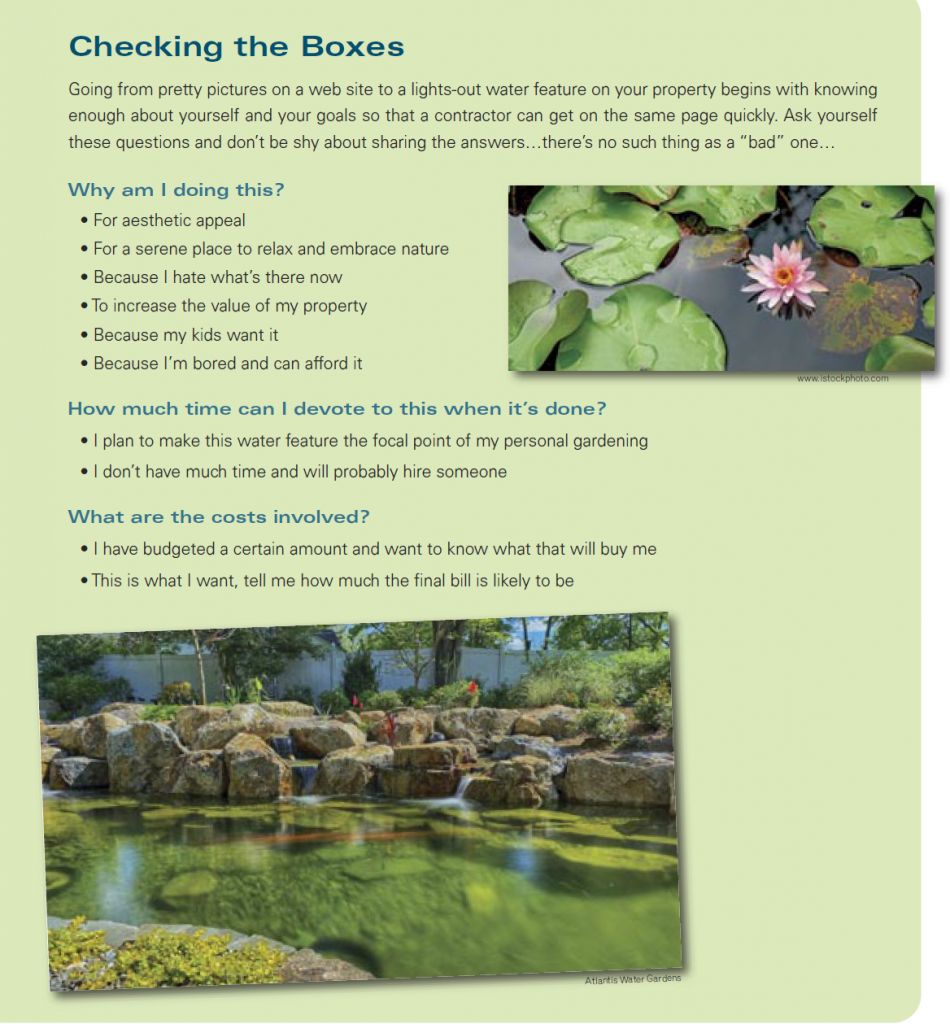
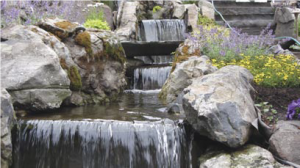
Aquatic Art
For those who cannot truly relax without the sound of rushing water, a backyard waterfall is the perfect home improvement. While certain pond and fountain projects can be tackled by DIYers, designing and building a waterfall almost always involves an experienced professional.
Waterfalls are usually integrated into an existing or planned swimming-pool design or installed as a standalone feature that takes advantage of natural elements on your property, such as rock outcroppings or boulders, which are capable of supporting a waterfall as an independent structure. An interesting alternative to a waterfall is a waterwall.
Waterwalls are visually striking structures that generate a continuous curtain of cascading H2O, offering many of the same benefits of a traditional waterfall, particularly if you are constricted by space and/or expense. Along the same lines, water sconces—which have been around for centuries—deliver the soothing trickle in an even smaller space.
What Does it Cost? What is it Worth?
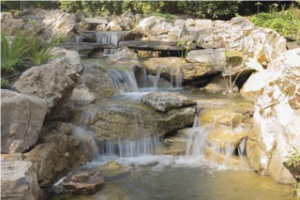
Aquatic Art
Let’s look at the second question first. Does a water feature add enough value to your property to justify the expense? As is the case with a swimming pool, the answer is a firm maybe. Home buyers tend to either want a pool or not. Where fountains, ponds and waterfalls are concerned, they unquestionably add to the esthetic appeal of a home—after all, that’s why they were built in the first place. Of course, someone could “love the house and hate the pond,” but that is a matter of taste and an unwanted water feature can be dismantled or filled in without significant expense, if that’s the way the new owner wants to go. A realtor looking at this question would hope that a beautiful fountain might prove to be the deciding factor between two homes…or that it captures the imagination of an otherwise hesitant buyer enough to make an offer on a listing.
The folks who design, build and install custom water features look at it more organically, as they should. If the project is within your financial wherewithal, measure it not in dollars, but rather in the degree of satisfaction and enjoyment it brings.
For most people the first step toward basic answers is meeting with experienced professional contractors capable of delivering a personalized water feature creation. Two that have demonstrated decades of success in the design and construction of unique aquatic landscapes are Atlantis Water Gardens and Aquatic Art. They are among a dozen or so companies in and around New Jersey whose web sites are filled with dreamy photos of finished projects. “My business is luxury- and leisure-oriented,” says Mark Yonadi, owner of Aquatic Art. “I am creating a lifestyle, not just a water feature. My goal is that the client really uses and enjoys what I create…I design, then I build my designs. I do it because I love it.”
Jaak Harju, owner of Atlantis Water Gardens, echoes this sentiment, adding, “I want my clients to enjoy the garden from multiple vantage points, indoors and out. I want to create a living picture, something that changes with every visit.”
Both agree that a great “water gardenscape” (or water garden escape) is fueled by passion and inspiration. It is what buoyed them through the initial uncertainty of COVID, which exploded at the beginning of their busy season, in late March 2020. By that summer, however, both companies were besieged by requests from cooped-up homeowners who had nowhere to vacation other than their own backyards. “Business was booming again after only a few initial setbacks,” Harju says.
Yonadi says commercial projects tailed off during COVID, but backyard projects of all types and sizes “never experienced any hiccups.” He adds, with pride, that he managed to keep all his employees working and his team safe.
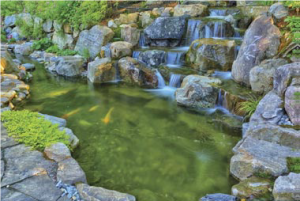
Atlantis Water Gardens
Pricing of high-quality custom water features covers a wide range based on countless variables. After all, that’s why they’re called custom. As a rule, though, figure on a starting price of $5,000 and don’t be surprised if achieving your vision runs into the mid-five figures. If you’ve got seven figures burning a hole in your bank account, that can happen, too. Harju, who was named Water Feature Artist of the Year in 2014, once worked on a commercial project in South America that priced out at $2.7 million. On the plus side, he points out, most of his projects require less time of the homeowner and involve less expense than maintaining a large suburban lawn.
HomeAdvisor recently compiled some pricing data that shouldn’t surprise New Jersey homeowners. The average price of a fountain or waterfall designed and installed is 50% higher here than the national average. This undoubtedly reflects the involvement of plumbers and electricians. By contrast, a pond installation in New Jersey is about the same as the national average.
The fish part of the equation can be exasperating for a novice, especially if they are dying or being eaten by predators. There is no such thing as a “bargain” koi, so you want to get it right as soon as possible. For his part, Yonadi spent years cultivating his aquarium skills—first as a hobby and then as a thriving part of his business. His company will stock your pond and/or aquarium, provide all the necessary equipment to sustain successful ecosystems, and offer follow-up maintenance. One final piece of advice upon which both men agree is that, during an initial consultation, a good water feature company will listen to a prospective client.
But a good client will also listen when they make a recommendation.
“Yes,” Harju smiles. “Sometimes, we know best.”
There’s a lot going on in Indian curry dishes… but maybe not as much as you think.
Indian food is difficult to cook unless you own an Indian restaurant. In places like New Jersey, where this cuisine has become increasingly popular, even the most intrepid diners still operate under this assumption. Home chefs who have mastered the intricacies of Vietnamese Pho, Thai stir fry, Jamaican jerk chicken and Brazilian barbecue not only tend to be intimidated by the thought of diving into Indian curry, they find the thought of navigating their way through the aisles of places like Patel Brothers utterly terrifying.

www.istockphoto.com
Granted, if you’re new to cooking Indian curries at home, you might feel a little overwhelmed. Curry is all about subtlety and complexity, after all. But once you stop to take it all in and begin to learn the differences in the food of the wonderful country of India, things will start to fall into place. Your journey into Indian cuisine will be easy and enjoyable, and change any preconceived ideas that Indian food is difficult to cook.
With 29 states and seven union territories, it is said that the language and food of India changes every 50 miles as you travel the subcontinent. Each state has its own regional specialties, and then there are sub-cuisines that reflect religion, caste, the climate and availability of local ingredients. For example, a lentil stew called sambar—known throughout the country’s southern states—will be made slightly differently wherever you visit.
Not surprisingly, everyone claims that their version is the best. Sound familiar?
It would be impossible to put all the curries of India in a single book. Great tomes have been written, and still none can be considered truly comprehensive; such is the nature of a cuisine that caters to almost 1.4 billion people—and where the ingredients used in a dish can change from village to village and even household to household (all without recipes to guide them!). It is testament to Indians’ love of food that a recipe will be refined and perfected over time to suit personal tastes: a little more spice here, a different vegetable there, and then passed down through the generations to create family favorites.
Despite these subtle differences, there are, of course, popular dishes that everyone cooks and for which India is famous, and last year I collected 50 of the best (and easiest) vegan, vegetarian and non-vegetarian recipes to make from scratch in 50 Easy Indian Curries. I also included simple instructions for pastes, rice and breads to complete an Indian meal. With a few essential Indian pantry staples and fresh ingredients—all of which can be found at any decent supermarket—each curry can be made in an hour or less, or thrown into a saucepan and left to slow cook on the stove while you get on with something else. The keys are ease and speed (plus some fun shopping adventures).
Make A List

www.istockphoto.com
On your next trip down the GSP to Patel’s (or another of New Jersey’s growing number of South Asian supermarkets), bring this list along. It’s what you’ll need to stock your “Indian Pantry” and execute every curry recipe in this article.
Asafoetida • Pure asafoetida (or heeng) has a strong, almost off-putting smell that dissipates when cooked and is used as a substitute for garlic and onions by Indians who avoid these ingredients. Just a pinch of asafoetida is enough to flavor a dish. You will find it in small plastic containers, diluted with rice or wheat flour to dull down the pungent smell.
Cardamom • Cardamom is a perfumed spice that is much loved throughout India. It is equally at home in baked treats and confections as in curries. You’ll notice the recipes in this story and in my book use both green and black cardamom pods, so buy both.
Chillies • Indian food is almost incomplete without chillies yet, ironically, the chilli plant is foreign to India—arriving with the Portuguese in the 15th century. Indian cuisine uses green and red fresh chillies, along with chilli powder, the most famous of which comes from Kashmir.
Cinnamon • Whereas cinnamon is often reserved for baking in the U.S., in India it is part of a collection of whole spices that are added to curries. Often confused with cassia—which comes from China and has a slight amount of heat—real cinnamon only grows in Sri Lanka.
Cloves • Cloves, which are not native to India, have a strong, astringent flavor profile and should be used sparingly in dishes.
Coriander • Coriander seeds are used extensively in Indian cuisine for their warm, nutty flavor. Lightly toasted, they become even more fragrant and, when powdered, they tone down other strong flavors, such as chilli. Coriander leaves (aka cilantro) are commonly added as a garnish and never cooked in order to retain their vibrant green color.
Fenugreek • The whole seeds are used as a tempering in dals, as well as being added to Indian pickles. Fresh fenugreek leaves are used extensively in cooking and their dried form—known as kasuri methi—is sprinkled on top of cooked dishes for its aromatic quality. It’s a true wonder spice.
Garam Masala • A powdery blend that roughly translates to “hot spice,” it actually doesn’t contain much heat. It is made by dry-roasting different types and quantities of spices and then blending them together. Garam masala is typically added at the end of cooking, the purpose being to add aroma and flavor, without overpowering the final dish.
Turmeric • Indian kitchens would be colorless without this wonderful spice. Known not just for its culinary use but also for medicinal and antiseptic qualities, turmeric is also the only spice that Hindus use for devotional purposes. The active ingredient in turmeric is curcumin, which is known for its healing properties. Once you gain confidence, you may even find yourself adding your own twists and flourishes. Indian food, after all, is more than an explosion of flavors, colors and spices. Like all the great world cuisines, it is a form of personal expression. Here are a half-dozen relatively simple curry dishes—each serving four—that you can make in your own kitchen and, ultimately, make your own…

Eggplant Masala
Eggplant is a popular ingredient in Indian cuisine. Roasted, grilled or fried, it adds a “meatiness” to vegetarian curries. This eggplant masala is simple and quick to make and goes perfectly with other curries. The yogurt adds a delightful fresh touch.
You’ll need…
2 large (about 2 lb.) eggplants (aubergines), cut into (3/4”) chunks
1/2 teaspoon sea salt
2 tablespoons ghee or vegetable oil
1 teaspoon black mustard seeds
3 Asian shallots, sliced
2 (3/4”) pieces of ginger, finely grated
2 garlic cloves, thinly sliced
1 long red chilli, chopped
14 oz. canned crushed tomatoes
1/2 teaspoon ground cinnamon
1/4 teaspoon ground cardamom
pinch of ground cloves
1/4 cup of natural yogurt
Cilantro and papadam (Papadam is a deep-fried crunchy dough that can be purchased pre-packaged or made at home.)
Place the eggplant in a large bowl and sprinkle with the salt. Toss to combine and set aside for 30 minutes. Rinse well and pat dry with paper towel. Heat a large heavy-based non-stick frying pan over high heat. Working in batches if necessary, add the eggplant to the dry pan and cook, stirring occasionally, for 5-6 minutes per batch, until lightly browned all over. Transfer to a plate and set aside. Heat the ghee or oil in the same frying pan over medium-high heat. Add the mustard seeds and sizzle for a few seconds. When the seeds start to crackle, add the shallot, ginger, garlic and chilli. Reduce the heat to medium and cook for 4-5 minutes, stirring occasionally, until the onion is golden. Add the tomatoes, cinnamon, cardamom, cloves and 125 ml (1/2 cup) of water and return the eggplant to the pan.
Cover and cook, stirring occasionally, for 10-15 minutes, until the eggplant is very tender and the sauce has thickened slightly. Season with a little salt, if necessary. Spoon the yogurt over the curry, garnish with coriander leaves and serve with papadams on the side.

Goan-Style Vegetable Curry
The state of Goa on the southwestern coast of India is known for its delicious fish curries, beer and a very chilled-out approach to life. But Goa also has many vegetarian dishes in its culinary repertoire, and this vegetable curry is one of the best. Coconut grows abundantly in the region, and here it adds a subtle, creamy flavor that elevates the dish.
You’ll need…
2 tablespoons coconut oil or vegetable oil
10 oz. cauliflower florets
1 large potato, peeled and cut into 1/2” pieces
1 onion, chopped
1 tomato, finely chopped
1 tablespoon ginger and garlic paste
2 small green chillies, sliced
1/2 teaspoon ground cumin
1/2 teaspoon ground turmeric
8 fl. oz. coconut milk
1 large carrot, chopped
5-6 oz. green beans, trimmed and sliced
1/4 cup freshly grated coconut, plus extra to serve (You can also use frozen grated coconut, which can be purchased at most NJ grocery stores.)
1/2 teaspoon sea salt
A handful of cilantro, chopped, plus extra to serve
1-2 teaspoons tamarind purée, to taste
Steamed basmati rice
Heat a large frying pan over medium heat and add half the oil. Add the cauliflower and potato and sauté for 4-5 minutes, until lightly browned. Transfer to a plate and set aside. Add the remaining oil to the pan along with the onion and sauté for 5-6 minutes, until softened. Add the tomato and cook for 2 minutes or until softened, then add the ginger and garlic paste and cook until fragrant. Add the chilli and spices and cook, stirring, for a further 2 minutes or until fragrant.
Add the coconut milk, along with 1 cup of water, all the vegetables and the grated coconut, and bring to a boil over medium heat. Reduce the heat to a simmer, season with the salt and cook (covered) for 10-12 minutes, until the vegetables are tender. Stir in the chopped coriander and tamarind, to taste. Garnish with extra coriander and/or extra coconut and serve with steamed basmati rice.

Goan-Style Prawn Curry
Goans are particularly proud of their prawn curries and when you make this you’ll see why. The key to this dish is to ensure that the prawns are not overcooked. Served with lime wedges for extra zing. Like all of the dishes in this story, it serves four but be warned: Everyone will probably be going back for seconds.
You’ll need…
1 tablespoon peanut oil
1 onion, finely chopped
1 small tomato, finely chopped
1 tablespoon ginger and garlic paste
2 teaspoons sweet paprika
1 teaspoon ground coriander
1/2 teaspoon ground cumin
1/2 teaspoon freshly ground black pepper
1/2 teaspoon cayenne pepper
10 fl oz. coconut milk
2 lbs. raw prawns, peeled and deveined, with tails left intact
1/2 teaspoon sea salt
1-2 teaspoons tamarind purée, to taste
Cilantro for garnish
Steamed basmati rice
Lime wedges
Heat the oil in a large frying pan over medium heat. Add the onion and cook, stirring occasionally, for 6-8 minutes, until softened and starting to brown. Add the tomato and cook for 2 minutes, or until softened. Add the ginger and garlic paste and cook until fragrant.
Add the spices and cook, stirring, for a further 2 minutes.
Add the coconut milk and bring to a boil, then reduce the heat to a simmer and add the prawns, salt and tamarind purée. Stir and cook for 4-5 minutes, until the prawns are just cooked through. Scatter with coriander leaves and serve with steamed basmati rice and squeeze the lime over the entire dish.

Tandoori Chicken
A tandoor is a clay oven set into the earth and fired with wood or charcoal. It can reach eye-watering temperatures of up to 900°F, allowing marinated meat to cook very quickly. Alas, not many of us have a tandoor in the backyard, but you can still rustle up a reasonable facsimile of this dish using a domestic oven. The trick is to spatchcock (aka butterfly) the chicken— a technique that will change your culinary life if you don’t know it already, even if you never cook a single Indian meal.
You’ll need…
Whole chicken, about 3 1/2 lb.
3/4 cup natural yogurt
1/2 cup Tandoori curry paste (see below)
Cilantro
Lemon wedges
1 package/4 pc. of naan
First, butterfly the chicken. Using kitchen scissors, cut along both sides of the backbone and remove. Turn the chicken over and place on a clean work surface. Using the heel of your hand, press down firmly on the breastbone to flatten. Score the chicken about 1/2 in. deep through the thickest parts of the breast, thighs and legs. Combine the yogurt and tandoori curry paste in a bowl, then rub all over the chicken, rubbing well into the scored areas. Transfer to a baking tray lined with baking paper, then cover and marinate in the fridge for 2-4 hours.
Preheat the oven to 465°F, using the convection option if you have it. Roast the chicken for 30 minutes or until it starts to char in spots. Reduce the oven temperature to 300°F and continue to roast the chicken for 5-10 minutes, until cooked through. Remove from the oven and set aside to rest, covered loosely with foil, for 10 minutes. Scatter the coriander over the chicken and serve with lemon wedges and naan on the side.


Malai Kofta
Everyone in New Jersey seems to have their own family recipe for meatballs. Well, since kofta is basically an Indian meatball, this may be your initial comfort zone. Malai kofta is an excellent dish to make when entertaining because it never fails to wow everyone. You can either serve the koftas on their own with the sauce on the side for dipping or stir the koftas through the curry at the end of cooking and serve with rice.
You’ll need…
14 oz. floury potatoes (low in moisture, high in starch)
Sea salt
1 cup grated paneer cheese (you can substitute tofu for vegans)
1 tablespoon finely chopped cashew nuts
1 tablespoon finely chopped raisins
3 tablespoons corn starch
1/2 teaspoon garam masala
1/2 teaspoon chilli powder (optional)
Vegetable oil for deep-frying
1/4 cup of cream
Steamed basmati rice
Malai kofta sauce…
1/3 cup of vegetable oil
1 onion, finely chopped
1 tablespoon ginger and garlic paste
2 cups puréed tomatoes
2 tablespoons cashew nuts, finely ground
1 teaspoon cumin seeds
1 teaspoon ground coriander
1/2 teaspoon ground turmeric
1 fresh or dried bay leaf
1 cinnamon stick
4 cloves
3 green cardamom pods, bruised
1/2 teaspoon dried fenugreek leaves, crushed
1/2 teaspoon garam masala
Peel the potatoes, then transfer to a saucepan, cover with cold water and add a good pinch of salt. Bring to a boil and cook until tender. Drain, then mash and set aside to cool. Combine the potato, paneer, cashews, raisins, corn starch, garam masala, chilli powder (if using) and 1/2 teaspoon of salt in a bowl. Knead the mixture into a soft dough, then divide into 12 portions and roll into smooth balls. Set aside.
To make the sauce, heat three-quarters of the oil in a frying pan over low heat. Add the onion and ginger and garlic paste and cook for 10 minutes. Add the tomato purée, ground cashews and 1 cup of water and simmer for 5-7 minutes, until slightly thickened. Season to taste with salt. Transfer this mixture to a food processor and blitz to a smooth sauce. Wipe the pan clean. Heat the remaining oil in the pan over medium heat and add the cumin seeds, ground coriander, turmeric, bay leaf, cinnamon stick, cloves and cardamom pods and cook, stirring, for 1 minute, until fragrant. Pour the sauce back into the pan and add the fenugreek leaves and garam masala. Gently warm through.
Back to the kofta…Heat enough oil for deep-frying in a saucepan to 375°F. Working in batches, deep-fry the kofta for 2-3 minutes, until well browned on all sides. Transfer to a plate lined with paper towel to drain, then gently stir through the sauce. Transfer the malai kofta to a serving dish and drizzle the cream over the top. Serve with the steamed basmati rice on the side.

Lamb Rogan Josh
A famed dish from the beautiful state of Kashmir, the fiery red color of rogan josh comes from the chillies that are added in generous quantities. Rogan josh is usually cooked with tomatoes, but they are omitted here to allow the flavor of the lamb to shine through even more.
You’ll need…
2-plus lb. boneless lamb shoulder or leg, cut into 1” pieces
1 1/2 cups natural yogurt
1 teaspoon sea salt
2 oz. ghee (Indian clarified butter)
1 cinnamon stick
2 teaspoons green cardamom pods, bruised
4 brown or black cardamom pods, bruised
1/2 teaspoon cloves
3 onions, chopped
2 tablespoons ginger and garlic paste
1 tablespoon Kashmiri chilli powder
2 teaspoons sweet paprika
2 teaspoons ground turmeric
Large handful of chopped cilantro
1 teaspoon garam masala
4 pc. Paratha (Indian flatbread)
Combine the lamb, yogurt and 1/2 teaspoon of the salt in a large bowl. Cover and set aside to marinate. Heat the ghee in a heavy-based saucepan over medium heat. Add the cinnamon, cardamom pods and cloves and cook, stirring for 30 seconds or until fragrant. Add the onion and remaining salt, reduce the heat to medium–low and cook, stirring occasionally, for 20–25 minutes, until golden brown.
Add the ginger and garlic paste and cook, stirring for about 30 seconds, until fragrant. Add the lamb mixture, chilli powder, paprika and turmeric to the pan. Mix well and bring to a boil over medium heat. Reduce the heat to low and cook, covered, for 80 to 90 minutes, until the lamb is tender. Stir in the coriander and garam masala and season to taste. Serve with paratha on the side.
Editor’s Note: In her 50 Easy Indian Curries (Smith Street Books, $29.95), Penny Chawla covers restaurant classics—such as dal makhani, pork vindaloo and saag paneer—and lesser-known regional gems, including beef Madras and Bengali fish curry. “There is a curry here for everyone.” After watching Bend It Like Beckham, many wondered what was so special about making a “full Punjabi dinner.” Find this story at edgemagonline.com and look for bonus content that clears it all up!


